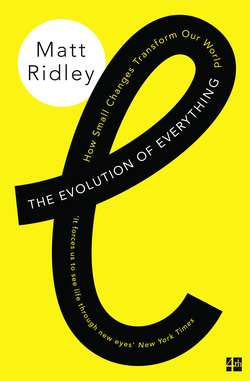Читать книгу The Evolution of Everything: How Small Changes Transform Our World - Matt Ridley, Matt Ridley - Страница 33
Red Queen races
ОглавлениеEven in the heart of genetics labs there is a long tradition of resistance to the idea that mutation is purely random and comes with no intentionality, even if selection is not random. Theories of directed mutation come and go, and many highly reputable scientists embrace them, though the evidence remains elusive. The molecular biologist Gabby Dover, in his book Dear Mr Darwin, tried to explain the implausible fact that some centipedes have 173 body segments without relying exclusively on natural selection. His argument was basically that it was unlikely that a randomly generated 346-legged centipede survived and bred at the expense of one with slightly fewer legs. He thinks some other explanation is needed for how the centipede got its segments. He finds such an explanation in ‘molecular drive’, an idea that remains frustratingly vague in Dover’s book, but has a strong top–down tinge. In the years since Dover put forward the notion, molecular drive has sunk with little trace, following so many other theories of directed mutation into oblivion. And no wonder: if mutation is directed, then there would have to be a director, and we’re back to the problem of how the director came into existence: who directed the director? Whence came this knowledge of the future that endowed a gene with the capacity to plan a sensible mutation?
In medicine, an understanding of evolution at the genomic level is both the problem and the solution. Bacterial resistance to antibiotics, and chemotherapeutic drug resistance within tumours, are both pure Darwinian evolutionary processes: the emergence of survival mechanisms through selection. The use of antibiotics selects for rare mutations in genes in bacteria that enable them to resist the drugs. The emergence of antibiotic resistance is an evolutionary process, and it can only be combated by an evolutionary process. It is no good expecting somebody to invent the perfect antibiotic, and find some way of using it that does not elicit resistance. We are in an arms race with germs, whether we like it or not. The mantra should always be the Red Queen’s (from Lewis Carroll’s Through the Looking-Glass): ‘Now, here, you see, it takes all the running you can do, to keep in the same place. If you want to get somewhere else, you must run at least twice as fast as that!’ The search for the next antibiotic must begin long before the last one is ineffective.
That, after all, is how the immune system works. It does not just produce the best antibodies it can find; it sets out to experiment and evolve in real time. Human beings cannot expect to rely upon evolving resistance to parasites quickly enough by the selective death of susceptible people, because our generation times are too long. We have to allow evolution within our bodies within days or hours. And this the immune system is designed to achieve. It contains a system for recombining different forms of proteins to increase their diversity and rapidly multiplying whichever antibody suddenly finds itself in action. Moreover, the genome includes a set of genes whose sole aim seems to be to maintain a huge diversity of forms: the major histocompatibility complex. The job of these 240 or so MHC genes is to present antigens from invading pathogens to the immune system so as to elicit an immune response. They are the most variable genes known, with one – HLA-B – coming in about 1,600 different versions in the human population. There is some evidence that many animals go to some lengths to maintain or enhance the variability further, by, for example, seeking out mates with different MHC genes (detected by smell).
If the battle against microbes is a never-ending, evolutionary arms race, then so is the battle against cancer. A cell that turns cancerous and starts to grow into a tumour, then spreads to other parts of the body, has to evolve by genetic selection as it does so. It has to acquire mutations that encourage it to grow and divide; mutations that ignore the instructions to stop growing or commit suicide; mutations that cause blood vessels to grow into the tumour to supply it with nutrients; and mutations that enable cells to break free and migrate. Few of these mutations will be present in the first cancerous cell, but tumours usually acquire another mutation – one that massively rearranges its genome, thus experimenting on a grand scale, as if unconsciously seeking to find a way by trial and error to acquire these needed mutations.
The whole process looks horribly purposeful, and malign. The tumour is ‘trying’ to grow, ‘trying’ to get a blood supply, ‘trying’ to spread. Yet, of course, the actual explanation is emergent: there is competition for resources and space among the many cells in a tumour, and the one cell that acquires the most helpful mutations will win. It is precisely analogous to evolution in a population of creatures. These days, the cancer cells often need another mutation to thrive: one that will outwit the chemotherapy or radiotherapy to which the cancer is subjected. Somewhere in the body, one of the cancer cells happens to acquire a mutation that defeats the drug. As the rest of the cancer dies away, the descendants of this rogue cell gradually begin to multiply, and the cancer returns. Heartbreakingly, this is what happens all too often in the treatment of cancer: initial success followed by eventual failure. It’s an evolutionary arms race.
The more we understand genomics, the more it confirms evolution.
